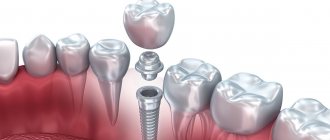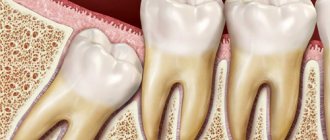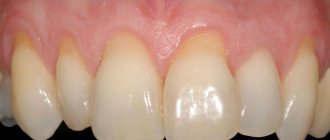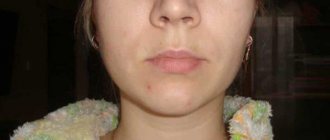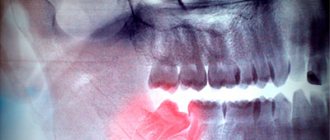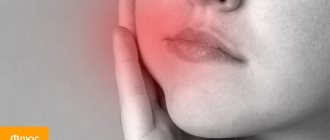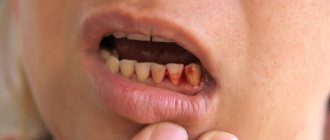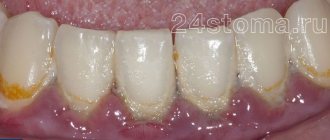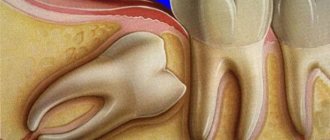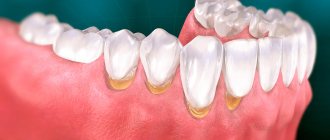Causes Symptoms Treatment Possible complications Prevention
Gum hyperplasia is a condition in which tissue begins to grow excessively. They hang over the teeth, forming false pockets, covering most of them, interfering with hygiene procedures. There are several terms in the literature that describe this condition: gingival overgrowth, hypertrophy, or hypertrophic gingivitis.
The main danger of tissue proliferation is that it promotes the proliferation of bacteria, causing serious diseases such as periodontitis.
Causes of gum hypertrophy
The main reason for tissue hypertrophy in the mouth is poor hygiene. Remains of food and decay products settle on the enamel of the teeth. They accumulate, causing inflammation of the mucous membrane, one of the manifestations of which is hyperplasia.
Other reasons include:
- Taking certain medications
A side effect of some anticonvulsants and immunosuppressants, and some heart medications, is gum overgrowth. However, you should not stop taking them or reduce the dosage if your gums have increased in size and began to bleed, without consulting a doctor.
- Genetic predisposition
Most people experience tissue growth during puberty. In most cases, after the end of hormonal changes, spontaneous reduction is observed. But in some patients, the gums do not shrink and may even increase in size. This phenomenon is characteristic of hereditary fibromatosis.
- General diseases
Leukemia almost always provokes tissue hypertrophy because they are saturated with dense masses of immature leukocytes. The gum turns into a hard surface on which wounds appear at the slightest pressure. This problem is also typical for sarcoidosis.
- Hormonal instability
Pregnancy and diseases of the endocrine system, such as diabetes or hypothyroidism, disrupt metabolic processes in tissues and lead to inadequate growth.
- Crowded teeth
If teeth creep onto each other and overlap surfaces, this interferes with proper cleaning of surfaces and contributes to the formation of microbial plaques. They, in turn, provoke inflammation.
Preparing for surgery
Before the operation, doctors at the Denta-Professional clinic perform x-ray diagnostics, which allows them to assess the degree of inflammation and determine treatment tactics. In cases of abnormal growth of the figure eight, the development of caries or pulpitis of the third molar, it may be necessary to remove the tooth itself. Also, the figure eight is removed if there is not enough space in the dentition.
The operation does not require special preparation; it can be performed on the same day of contacting the surgeon at our clinic in Moscow. If the doctor diagnoses severe purulent inflammation, the hood will first be cut to ensure unimpeded outflow of purulent contents, and antibacterial therapy will be prescribed. Excision (removal of part of the mucosa) in such cases is carried out at the next appointment, after the active inflammatory process has subsided.
The doctor at the Denta-Professional clinic, located on the border with Lyubertsy, will determine the optimal treatment tactics that are most effective and comfortable for the patient.
Symptoms
The growth of the mucous membrane is a gradual process. There are 3 degrees:
- The gingival papillae increase in volume. The gingival contour is disrupted and hangs over the tooth.
- The growth progresses, the tissue covers up to half of the coronal part. Bleeding and discomfort when brushing teeth and eating food develop.
- The gum covers the tooth by two thirds, sometimes completely. Folds form in which microflora accumulate, causing inflammation.
The process is generalized
when the entire gum on the jaw suffers.
Focal
hyperplasia is located around one or more teeth.
The edematous form is characterized by the presence of plaque, there is a lot of it, it is quite soft, but covers the enamel with a thick layer. Gum pockets form. The papillae turn red and bleed when pressed.
Patients complain of itching, discomfort in the mouth while eating, and an unpleasant odor.
With fibrous gingival hyperplasia, patients are only concerned about the unusual appearance of the mucous membrane. There is usually no pain or bleeding, but there are complaints of an unpleasant odor.
How to understand that you need to remove the figure eight hood
Surgery is not the only way to treat pericoronitis, but doctors insist on excision in the following cases:
- Pus accumulates between the dental crown and the hood.
- Severe pain radiating to the neck and temple.
- The mucous membrane over the wisdom tooth is dense and overhanging.
- The gums in the area of the erupting tooth become inflamed.
For mild pericoronitis, drug therapy is possible, but more often the patient turns to a surgeon when the inflammatory process has already developed and causes severe discomfort. In this case, the only treatment option is excision of the hood.
Treatment of gum hyperplasia
Any medical intervention is preceded by diagnosis. The clinic conducts a visual examination using dental instruments. An X-ray is taken and, in some cases, a tissue biopsy. Collect information about current diseases and what medications the patient is taking.
Gingival hypertrophy is differentiated from papillomas, granulomas, epulis (neoplasms) or swelling of the gums as a result of periodontitis.
The treatment plan is drawn up taking into account the degree, course and reasons for which the gums have grown.
For concomitant diseases, procedures should be agreed with the attending physician. Sometimes, simply changing the drug leads to a reduction in overgrown tissue.
Therapeutic methods
They are used mainly after replacing the drugs that caused hyperplasia.
- Decoctions and applications
from oak bark, chamomile, St. John's wort, calendula. Tannins in these plants narrow and strengthen the walls of blood vessels, reducing their permeability. As a result of combining with proteins, tannins form an insoluble film on the mucous membrane. This protects nerve endings from breakdown products and reduces pain.
- Installations in gum pockets.
Plant-based preparations are placed in pockets for 15-20 minutes, for up to 3 weeks.
- Dorsenval therapy.
After the elimination of the inflammatory process, physiotherapy is carried out to strengthen blood vessels.
The main treatment measure is professional teeth cleaning.
If the effect of the procedures is insignificant, as well as with fibrous hyperplasia, gingivectomy
.
Surgery
In cases where the gum has grown on the tooth so much that it covers half of the surface or more, the excess tissue is removed. For fibrosis, therapeutic treatment is not used at all; in other cases, the decision depends on the clinical picture.
The operation is performed under local anesthesia. Apply:
- Classic way
. The tissue is excised with a scalpel. The surface of the roots is polished with instruments, and the wound is treated with an antiseptic. Finally, a special bandage is applied (septopak, vokopak). - Laser
removal of overgrown gums . This is a minimally invasive operation, after which healing occurs much faster. During surgery, the vessels are sealed with a laser beam, which eliminates bleeding. At the same time, pathogenic flora is destroyed. Complications after such operations are extremely rare.
How is the procedure performed?
Before starting the procedure, the dental surgeon takes into account all the individual characteristics of the patient: age, allergic reactions, chronic diseases, etc. After making sure that the procedure can be carried out, the doctor begins excision.
Stages of excision of the hood:
- X-ray diagnostics.
- Local anesthesia.
- Gum incision.
- Washing the wound.
- Applying a therapeutic bandage.
After surgery, the doctor schedules a follow-up appointment to examine the wound. As a rule, the gums heal in about ten days. If the process is delayed, this may be a symptom of complications.
Complications
Hyperplasia is dangerous because without treatment it provokes inflammatory processes in the periodontium: gingivitis and periodontitis. This leads to loosening of teeth and their loss.
Due to the fact that it is impossible to clean teeth well, caries often develops. Enamel demineralization occurs. Metabolic processes are disrupted.
Due to increased sensitivity, patients try not to chew on the side where the gum has grown. The chewing load is distributed unevenly, and the risk of losing teeth increases.
When to carry out the procedure and when to refrain from it
Indications for the procedure:
- strong pain;
- the appearance of putrid odor from the mouth;
- discharge of pus from the gums;
- swelling, bleeding and soreness of the gums;
- general weakness, elevated body temperature, dizziness and nausea (such symptoms are a sign of intoxication of the body).
Contraindications:
- mucosal infections (stomatitis, herpes, gingivitis, periodontitis);
- infectious diseases of the upper respiratory tract (sore throat, pharyngitis, laryngitis, etc.);
- exacerbation of chronic diseases.
Prevention
Simple measures will help prevent gum overgrowth. Dentists recommend brushing your teeth with a soft brush, using dental floss or interdental brushes. Using a rinse aid reduces the number of bacteria settling on the enamel. But all these measures will not help if there is plaque on the teeth. Therefore, professional teeth cleaning in dentistry is where the prevention of hyperplasia begins.
Author of the article Voznyuk Vladimir Aleksandrovich Maxillofacial surgeon-implantologist of the highest category
Work experience: 28 years.
Recovery phase and care
The doctor schedules a follow-up examination 2–3 days after the removal of the wisdom tooth hood at the dental clinic. During the operation, swelling, pain, and redness may appear. These phenomena gradually disappear after a few days. Prevention of complications is an important step after any operation. After excision of the wisdom tooth hood, the doctor prescribes various medications and procedures:
- Rinse solutions with antiseptics;
- Anti-inflammatory gels and ointments;
- Antibiotics to relieve inflammatory processes;
- Analgesics to relieve pain after surgery;
- Rinse with warm infusion of chamomile, calendula, yarrow.
Food and rinses should be warm. After surgery, in the first period you should not eat hot, cold, spicy, or sour foods. When brushing your teeth every day, you should avoid touching the operated part of your gums. Care and rehabilitation includes equally important points:
- You should not eat anything for several hours after surgery;
- Chew food carefully, try to eat with the opposite side;
- Switch to a diet that includes soft and warm foods;
- Quit smoking, alcohol, avoid exercise and exercise.
The doctor will advise the optimal regimen in the postoperative period, prescribe treatment and the day of the follow-up examination. If you follow the doctor’s recommendations, the risks of complications in the postoperative period are reduced, and the wound heals within 5 to 7 days. Call us and make an appointment for wisdom tooth hood removal in Moscow on our official website. The dental surgeon at our clinic accepts appointments by appointment. We provide services to eliminate any dental problems at low prices and provide emergency dental care in the most severe and urgent cases.
Gum plastic surgery during implantation
Gumplasty is performed when the root is exposed, after tooth implantation. Often the need for this operation arises when an implant is installed in place of a long-missing tooth. In this case, the correct gum line is not only aesthetic. It protects the implant from infection and the development of peri-implantitis, which without proper treatment can lead to the loss of the entire structure. In addition, it allows you to prevent further exposure of the roots, reduce tooth hypersensitivity, reduce the likelihood of root destruction and, of course, improve the aesthetics of your smile.
The procedure for plastic correction
With any type of surgical intervention, the technology remains unchanged and consists of the following stages:
- examination of the general condition of the gums, preparation of the oral cavity for surgery: elimination of caries, plaque, tartar;
- injection of an anesthetic;
- removing or cutting part of the gum using a scalpel or laser. If there is a shortage of gum tissue, it is transplanted from another place;
- suturing.
After the procedure, the doctor prescribes further treatment and indicates recommendations that should be followed.
How is the operation performed?
- Anesthesia Local anesthesia is used, which eliminates any discomfort. At the request of patients, the procedure can be performed under sedation.
- Operation Excision of excess gum according to the selected protocol, cleansing periodontal pockets of hard deposits and dental plaques.
- Antiseptic treatment Disinfection of the surgical area by repeated rinsing with antiseptics, applying a periodontal bandage.
The use of sedation ensures complete physical and emotional comfort for the patient during the procedure.
After surgery, the gums heal quickly. But in order to avoid complications, we ask you to strictly follow the doctor’s home care instructions.
Gum grafting: healing after surgery
Depending on the type of gum grafting, complete recovery takes from several days to several weeks. Your doctor will give you a list of recommendations to follow after surgery. He will also prescribe painkillers. In general, the recommendations boil down to the following: it is necessary to remain calm and reduce physical activity, eat soft foods at room temperature and avoid spicy foods until the gums are completely restored, and carefully carry out oral hygiene, including rinsing. Until complete healing, you will have to wear a special mouthguard that protects the affected areas from external factors and promotes faster and safer healing.
Swelling after surgery lasts for several days. As a rule, on the third day the swelling may increase, and then subside. If swelling does not go away, severe pain, bleeding or other frightening symptoms appear, you should immediately consult a doctor.
Gum grafting is a surgical procedure, and like any other, it has certain risks. The most common are allergies to the anesthetic and recurrent gum recession. In order to avoid allergies, you should notify your doctor in detail in advance about the presence of any diseases and the occurrence of allergies to medications in the past. In case of relapse, the procedure can be repeated no earlier than six months after the previous one.
Plastic surgery for gum recession
There are some periodontal diseases that cause gum recession. This is a condition in which the gum tissue shrinks and exposes the root of the tooth, which not only looks unsightly, but can also lead to many problems and even tooth loss. Recession can occur on one tooth or on several.
A too short and powerful frenulum or insufficient vestibule of the oral cavity, as well as some periodontal diseases, contribute to the detachment of the free edge of the gums, the formation of gum pockets, and inflammation. Vestibuloplasty can avoid this. This operation is performed in the vestibule of the oral cavity to deepen it and more rationally distribute soft tissue in this area.
In order to return the gum tissue to the required volume, cover exposed roots, prevent root caries and generally improve the aesthetics of a smile, gum augmentation is also performed. Depending on the situation, only connective tissue and epithelium can be built up, or maybe together with the periosteum. In the first case, such a flap is called split, in the second - complete.
Features of wisdom tooth eruption
Wisdom teeth or third molars, also known as figure eights, are the outermost teeth in a row, located at the edges of each jaw. There are four of them in total, but often not all of them erupt, and sometimes they may not grow at all.
This will not affect the chewing functions of the jaw, and if you do not have a single eight, there is no need to sound the alarm.
The eruption of third molars is possible at any age, even after 30 years; the patient’s age does not affect the course of the process. But the direction of growth, the presence of free space in a row, the structural features of the jaw can significantly influence the process - will it be painful or will it go unnoticed, will there be a health hazard and will the growth provoke the development of inflammation.
What can happen if you refuse the help of a specialist?
If the tooth root remains under the layer of gum tissue, decay can spread to neighboring units. In this case, treatment will be longer and more expensive. The main symptoms of this problem are a strong odor from the mouth and periodic pain that radiates to the head. Harmful microorganisms will begin to accumulate under the gums, which can lead to the development of caries.
In 99% of cases, the patient has a small sac with purulent filling at the apex of the root. After some time, it inevitably turns into a painful swelling called gumboil. The only correct solution when gums grow on a tooth is to quickly contact an experienced dentist. It will not only eliminate inflammation, but will also be able to save the destroyed unit.
previous post
What happens if you swallow toothpaste?
next entry
Technologies for gum correction before prosthetics
The choice of correction technology depends on the types of prostheses installed by the dentist for the patient. When installing a removable structure, the need for aesthetic plastic surgery of the gingival margin is eliminated due to the structure of the removable prosthesis, which consists not only of crowns, but also of artificial gum, replacing the natural one.
When installing fixed structures that do not have an artificial part, there will be a need for surgery to correct the natural gingival margin. The procedure can be carried out in three different ways.
- Gingivectomy - A surgical procedure aimed at removing part of the gum margin. The procedure is accompanied by the administration of an anesthetic. A specialist uses a surgical instrument (scalpel) to cut off a piece of mucous membrane.
- Gingivoplasty is a more complex surgical procedure that involves, in addition to excision of soft tissue, cleaning the pockets from microorganisms and purulent discharge. To do this, the gums are removed to the base of the tooth.
- Vestibulloplasty is the process of augmenting the missing part of the gum. The procedure consists of dissection, length correction and alignment of the gingival contour.
The above operations are carried out before prosthetics, usually using a surgical scalpel or laser. As a result, the patient receives a beautiful smile not only with new teeth, but also with new gums.
Miller classification
Today, the generally accepted classification of gum recession is the Miller classification, which is divided into 4 classes
.
First and second classes
according to Miller - root closure is 100 percent possible.
Third class
according to Miller, 100 percent root closure is impossible.
And fourth grade
according to Miller, he is not even being treated.
What treatments are available for each stage of gum recession?
For the first, second and third classes according to Miller - only surgical closure of the exposed necks of the roots of the teeth. The fourth class according to Miller is not treatable, that is, it cannot be treated.
Is there an age limit for treating gum recession?
No.
There is no age limit for treating gum recession.
Methods of conducting
The choice of technique depends on the severity of the disease
- Partial The least traumatic option involves excision of only the affected part of the periodontal tissue.
- Simple The entire volume of overgrown mucous membrane is removed, leaving only a 1 mm margin from the gum pocket.
- Radical Performed in severe cases, not only necrotic soft tissue is removed, but also the affected part of the bone.
Any surgical intervention on the gums should be carried out extremely carefully, with minimal tissue trauma. For this purpose, our Center uses a dental microscope, which increases visibility, increases the accuracy of manipulations, allows you to make neat cuts with special micro-instruments, and use the finest threads to apply sutures that do not injure the mucous membranes. All this ensures quick recovery, shortens rehabilitation time, and prevents possible complications.
